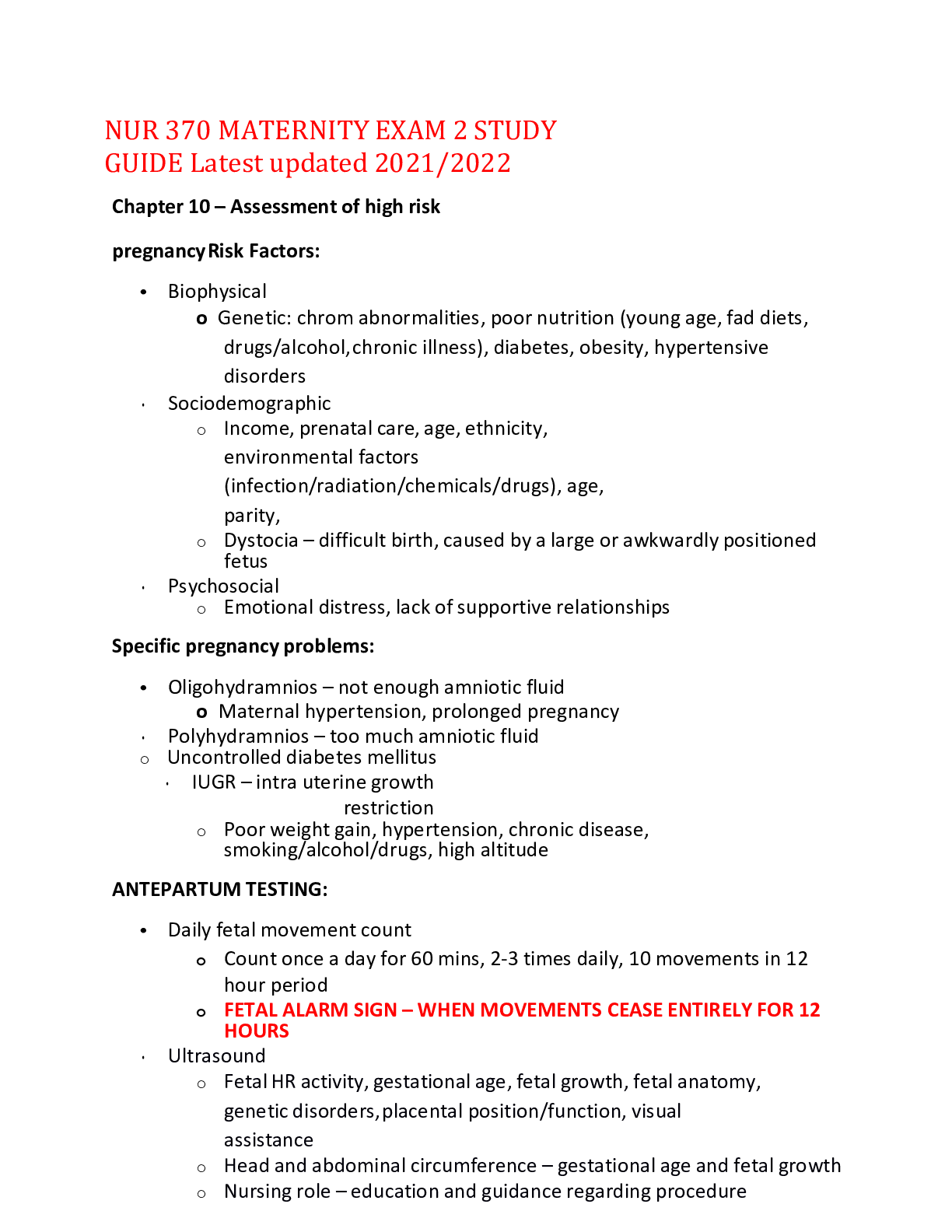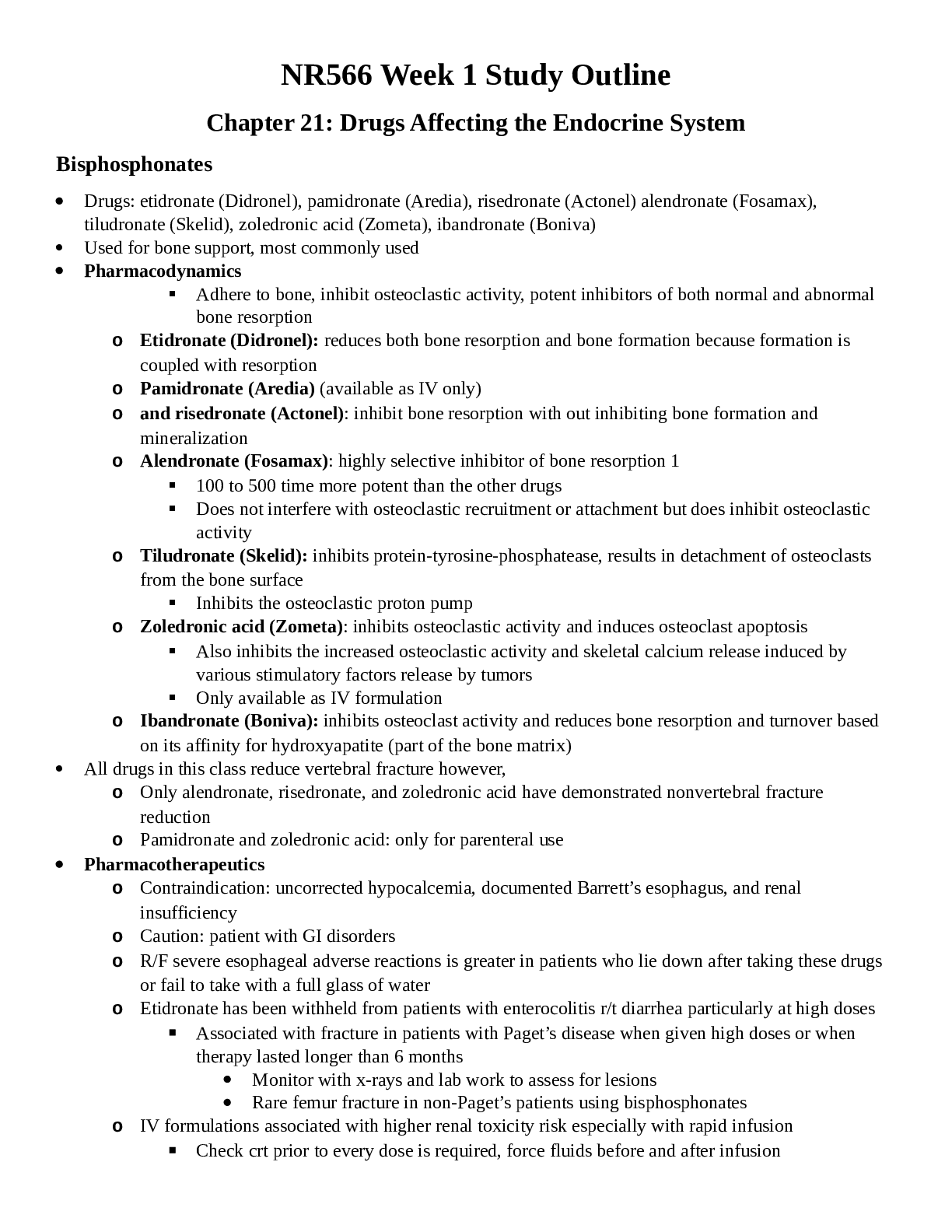Health Care > EXAM > CPH Exam Study Guide Latest Updated with Complete Solutions (All)
CPH Exam Study Guide Latest Updated with Complete Solutions
Document Content and Description Below
priority population - ANSWER In the planning process, the group being served needs assessment - ANSWER Assists to identify and prioritize health problems Chi-square - ANSWER Involves categorical... variables. Looks at 2 distributions of categorical data to see if they differ from each other. (for proportions) Two independent samples t-test - ANSWER Comparing two independent groups 2 sample dependent t-test - ANSWER Same sample of people compared twice Analysis of Variance (ANOVA) - ANSWER analysis of variance test used for designs with three or more sample means correlation analysis - ANSWER analysis of the degree to which changes in one variable are associated with changes in another SIP - ANSWER State Implementation Plan (SIP) approved by the EPA, standards for ambient air quality and requires States to participate in the implementation by developing a plan that meets Federal requirements Cryptosporidium parvum - ANSWER a water-borne, fecal-oral cycle pathogen that can cause severe diarrhea lasting for 1 - 2 weeks, headache, muscle pain, severe fluid and weight loss. The Apicomplexa have well developed sexual cycles and a structure (the Apical Complex) that helps them to attach to host cells. Flavivirus - ANSWER genus of viruses that includes mosquito-transmitted diseases such as Yellow Fever that are classified as water-related because part of disease's vector's lifestyle occurs in water Plasmodium spp. - ANSWER family of parasites that causes malaria, which, like flavivirus, is water-related Borrelia burgdorferi - ANSWER bacterial species that causes Lyme disease, the vector for which is the deer tick Vital statistics - ANSWER The collection, tabulation, and interpretation of data concerning birth, marriage, divorce, sickness, and death. DDT pesticide - ANSWER Causes "SILENT SPRING" (bird eggshell cracking) - EFFECTIVE vs. mosquitoes core functions of public health - ANSWER 1. Assessment 2. Policy Development 3. Assurance 10 essential public health services - ANSWER 1. Monitor health status to identify and solve community health problems. 2. Diagnose and investigate health problems and health hazards in the community. 3. Inform, educate, and empower people about health issues. 4. Mobilize community partnerships and action to identify and solve health problems. 5. Develop policies and plans that support individual and community health efforts. 6. Enforce laws and regulations that protect health and ensure safety. 7. Link people to needed personal health services and assure the provision of health care when otherwise unavailable. 8. Assure competent public and personal health care workforce. 9. Improve and innovate public health functions through ongoing evaluation, research, and continuous quality improvement 10. Build and maintain a strong organizational infrastructure for public health HACCP - ANSWER food safety system employed to Identify and control problems that may cause foodborne illness before they happen epidemiologic triangle - ANSWER describes the occurrence of disease as an interaction between Host, agent and environment Power - ANSWER ability to reject the null hypothesis when the null is in fact false Type I error (alpha) - ANSWER reject null when it was true (probability of this error is alpha) type 2 error - ANSWER fail to reject null when false (probability of this error is beta) level of significance - ANSWER alpha or α, is the probability of rejecting the null hypothesis when it is true cultural competence - ANSWER meet the social, cultural and linguistic needs of individuals within the community cultural awareness - ANSWER Knowledge of various cultural beliefs and values Succession Planning - ANSWER cultivate a new group of leaders incremental program budgeting - ANSWER a budget prepared using a previous period's budget or actual performance as a basis with incremental amounts added for the new budget period zero-based budgeting - ANSWER all expenses must be justified for each new period, starts from a "zero base," and every function within an organization is analyzed for its needs and costs Process evaluation - ANSWER how the program is delivered. It deals with issues such as when program activities occur, where they occur, and who delivers them and how many people participate in those activities. Triangulation - ANSWER the practice of using multiple sources of data or multiple approaches to analyzing data to enhance the credibility of a research study meta-analysis - ANSWER a "study of studies" that combines the findings of multiple studies to arrive at a conclusion Beneficence - ANSWER entails a moral obligation to help other persons Mission Statement - ANSWER a statement of the organization's purpose - what it wants to accomplish in the larger environment Cryptosporidium (causes Cryptosporidiosis) - ANSWER highly resistant to chlorine disinfection, and are responsible for numerous and increasing waterborne disease outbreaks social justice - ANSWER justice in terms of the distribution of wealth, opportunities, and privileges within a society health equity - ANSWER attainment of the highest level of health for all people Transtheoretical Model of Change - ANSWER precontemplation, contemplation, preparation, action, maintenance, relapse self-efficacy - ANSWER An individual's belief that he or she is capable of performing a task. Health Belief Model - ANSWER A theory of health behaviors; the model predicts that whether a person practices a particular health habit can be understood by knowing the degree to which the person perceives a personal health threat and the perception that a particular health practice will be effective in reducing that threat. perceived susceptibility - ANSWER one's opinion of chances of getting a condition perceived severity - ANSWER beliefs about the seriousness of a condition and its consequences perceived benefits - ANSWER the positive outcomes a person believes will result from the action Theory of Planned Behavior (TPB) - ANSWER a theory that predicts health behavior on the basis of six factors: personal attitude toward the behavior, behavioral intention, the subjective norm regarding the behavior, social norms, and perceived degree of control over the behavior, perceived behavioral control social cognitive theory - ANSWER learning occurs in a social context with a dynamic and reciprocal integration of the person, environment, and behavior- main concept of self-efficacy reciprocal determinism - ANSWER person, behavior, and the environment interact, each influencing the other in a reciprocal and dynamic fashion, thereby facilitating self-regulation and goal directed behavior. vicarious reinforcement - ANSWER Process by which a person learns how to interpret stimuli and anticipate reinforcement by watching others Diffusion of Innovation Theory - ANSWER A theory developed by E.M. Rogers to explain how a new idea or product gains acceptance and diffuses (or spreads) through a specific population or subset of an organization. innovation, communication channels, time, and social system SWOT analysis - ANSWER strengths, weaknesses, opportunities, threats PATCH - ANSWER Planned Approach to Community Health-CDC in partnership with state and local health departments and local communities APEX-PH - ANSWER Assessment Protocol For Excellence in Public Health: included CDC, APHA, and NACCHO MAPP - ANSWER Mobilizing for Action through Planning and Partnerships MAP-IT - ANSWER Developed in 2010 to allow communities to implement their adaptation of Healthy People 2020. Steps: Mobilize, Assess, Plan, Implement, and Track. Precede/proceed - ANSWER Phase 1 -Social Assessment: Quality of Life Phase 2 -Epidemiological Assessment: Health Issue and Behavioral, Genetic, and Environmental Issues Phase 3 -Educational and Ecological Assessment Includes the Predisposing, Reinforcing, and Enabling Factors Phase 4 -Administrative and Policy Assessment and Intervention Alignment Phase 5 -Program Implementation Phases 6-8 -Program Evaluation Predisposing factors - ANSWER knowledge, attitudes, beliefs, etc. that predisposes one to change Enabling factors - ANSWER resources and new skills to bring about behavior change Reinforcing factors - ANSWER feedback and reward system for behavior change Intervention Mapping - ANSWER involvement of community and planning groups throughout the process-with much brainstorming in each planning step Strategy - ANSWER general plan of action that may involve several activities and considers the characteristics of the priority population Method - ANSWER systematic approach or procedures used by the presenters, health educators, or others to share information, objectives, materials, etc Fidelity of Implementation - ANSWER The degree to which instruction follows the intent and design of the program formative evaluation - ANSWER assesses context in which a program is developed and can include a needs assessment or the development of program components-research that contributes to the design of a program, done to identify program strengths and weaknesses in order to guide improvement process evaluation - ANSWER determines whether a program is being implemented as intended summative evaluation - ANSWER Occurs after program components have been implemented. Assess the short-term and long-term effects of the program, conducted as a pass or fail examination that can lead to program termination utility - ANSWER ensures evaluation will be relevant and useful to program participants and stakeholders feasibility - ANSWER ensures the scope and activities within an evaluation are not over-reaching propriety - ANSWER addresses ethical consideration on behalf of those involved in the evaluation and those who are impacted by the results accuracy - ANSWER Addresses validity and adequacy of information used and conveyed Community Coalition Action Theory - ANSWER formation, maintenance, and institutionalization Includes engagement and consensus-building efforts among diverse organizations and individuals to address community-level issues Gatekeepers - ANSWER those who formally or informally control access to a priority population or control specific aspects of a community Opinion leaders - ANSWER respected community members who represent the view of the priority population Community Development - ANSWER community aims to develop group identity and cohesion Community Organizing - ANSWER identify common problems and goals, mobilize resources, and determine ways to meet goals Social Planning - ANSWER relies more on expert practitioners to solve problems Social Action - ANSWER address social inequities Functions of state health dept - ANSWER (1) health surveillance, planning, and program dev (2) promotion of local health coverage (3) setting and enforcement standards (4) providing health services 4th Amendment - ANSWER Freedom from unreasonable searches and seizures Federal Preemption - ANSWER Doctrine giving federal law precedence 10th Amendment - ANSWER The powers not delegated to the United States by the Constitution, nor prohibited by it to the States, are reserved to the States respectively, or to the people. ideological left - ANSWER concerned with personal interests, such as autonomy, privacy, and liberty ideological right - ANSWER focused on proprietary interests, that is, the freedom to conduct business, use and develop property, and contract freely personal libertarianism - ANSWER believes that public health officials should not confer compulsory powers of vaccination, isolate, and quarantine at all economic libertarianism - ANSWER believes that public health police powers interfere with free enterprise [Show More]
Last updated: 1 year ago
Preview 1 out of 22 pages

Reviews( 0 )
Document information
Connected school, study & course
About the document
Uploaded On
Oct 28, 2022
Number of pages
22
Written in
Additional information
This document has been written for:
Uploaded
Oct 28, 2022
Downloads
0
Views
37

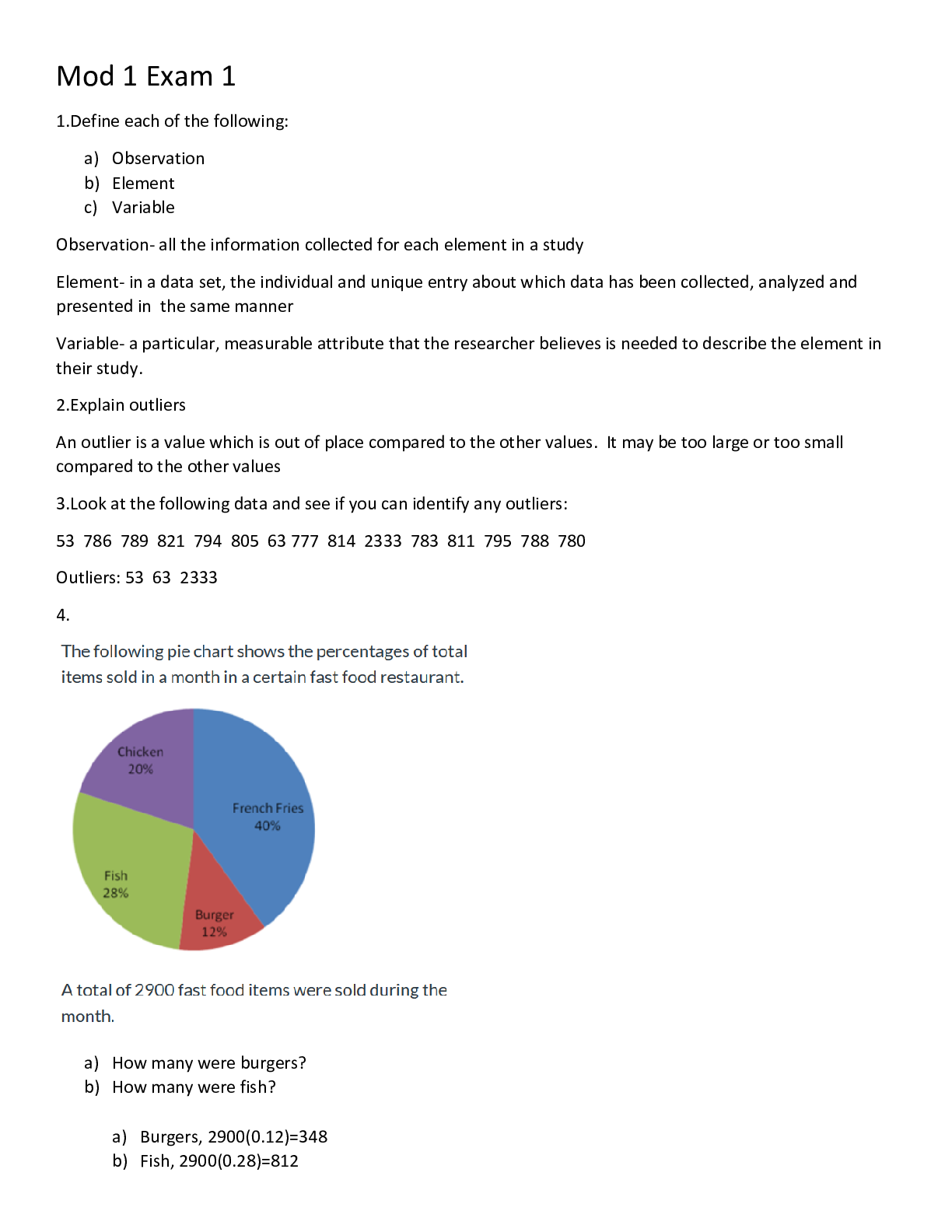


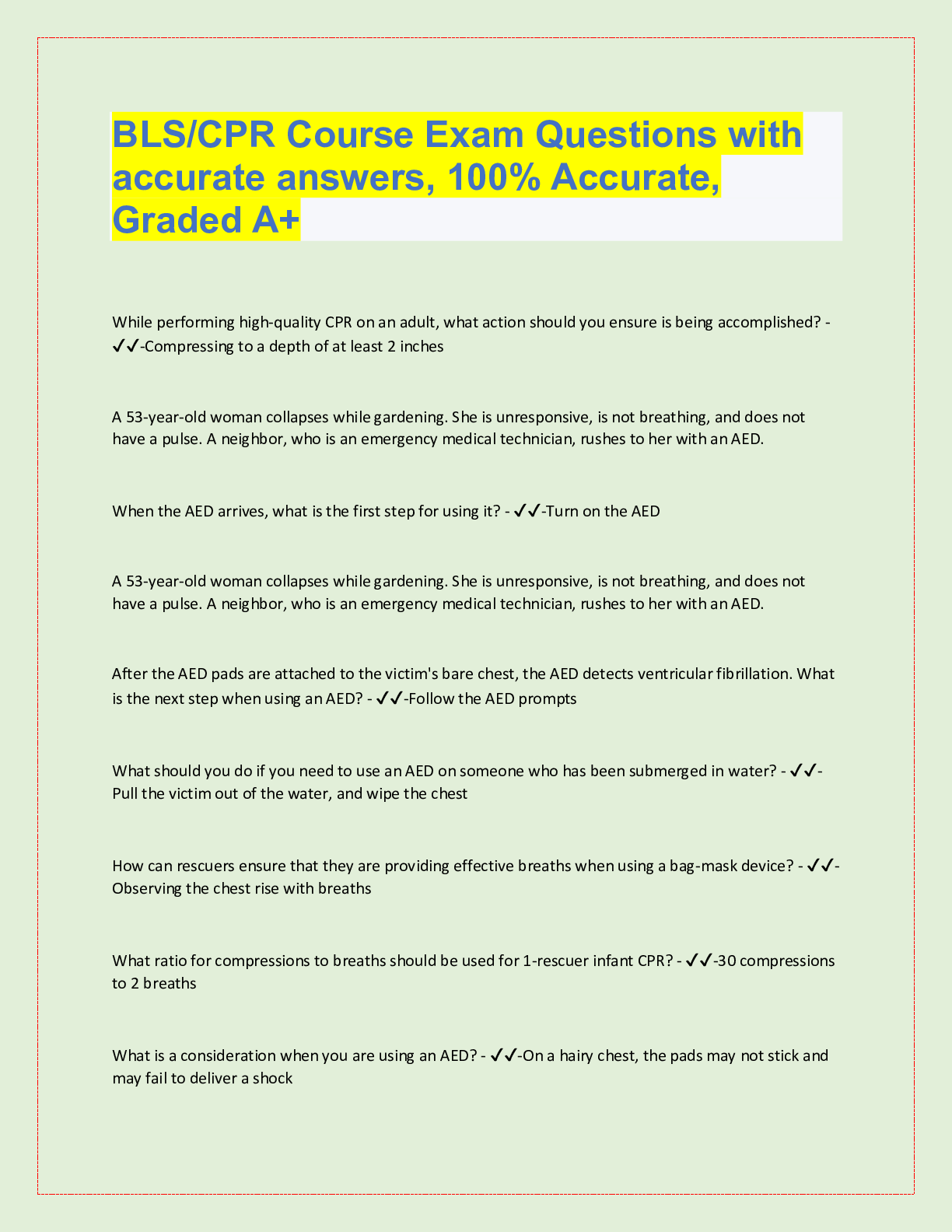
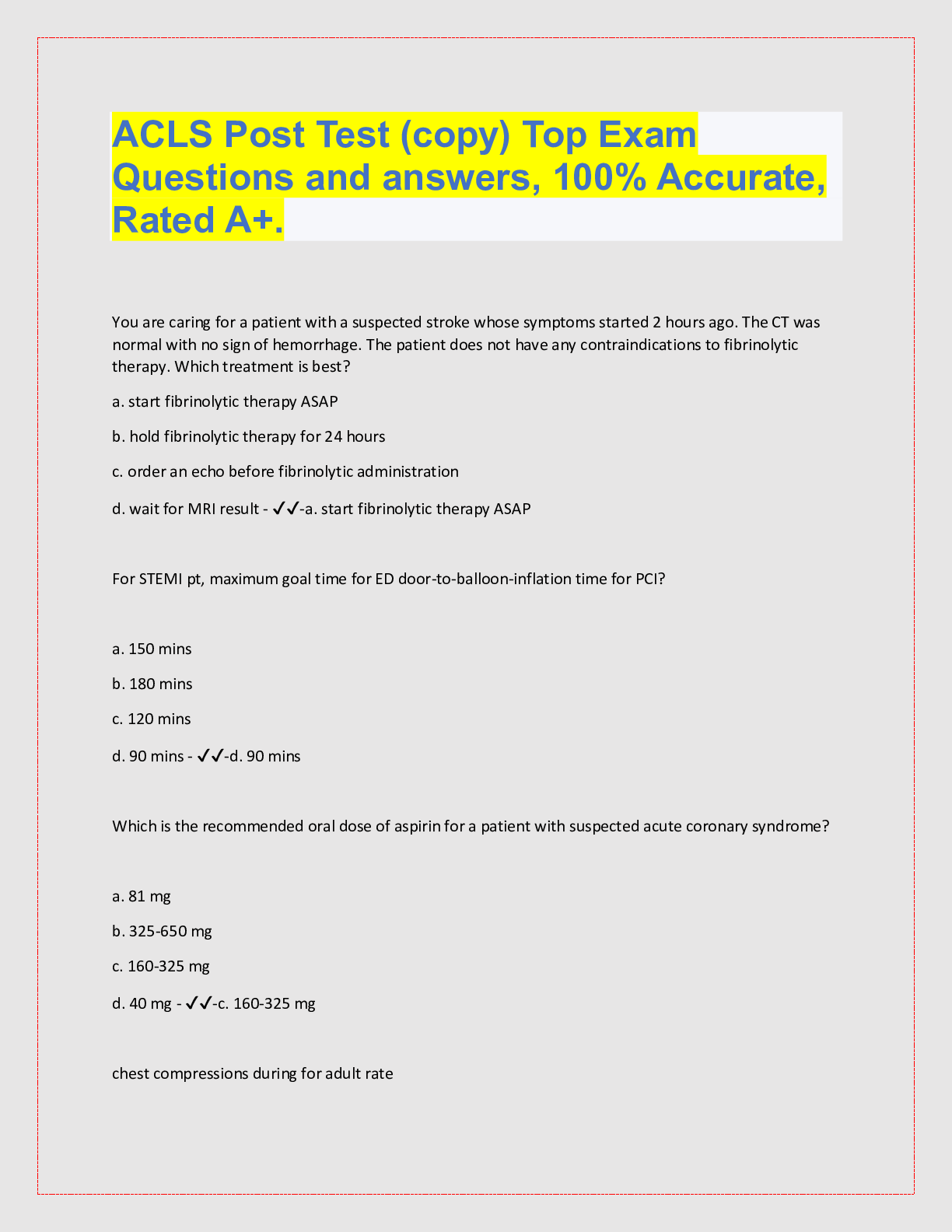
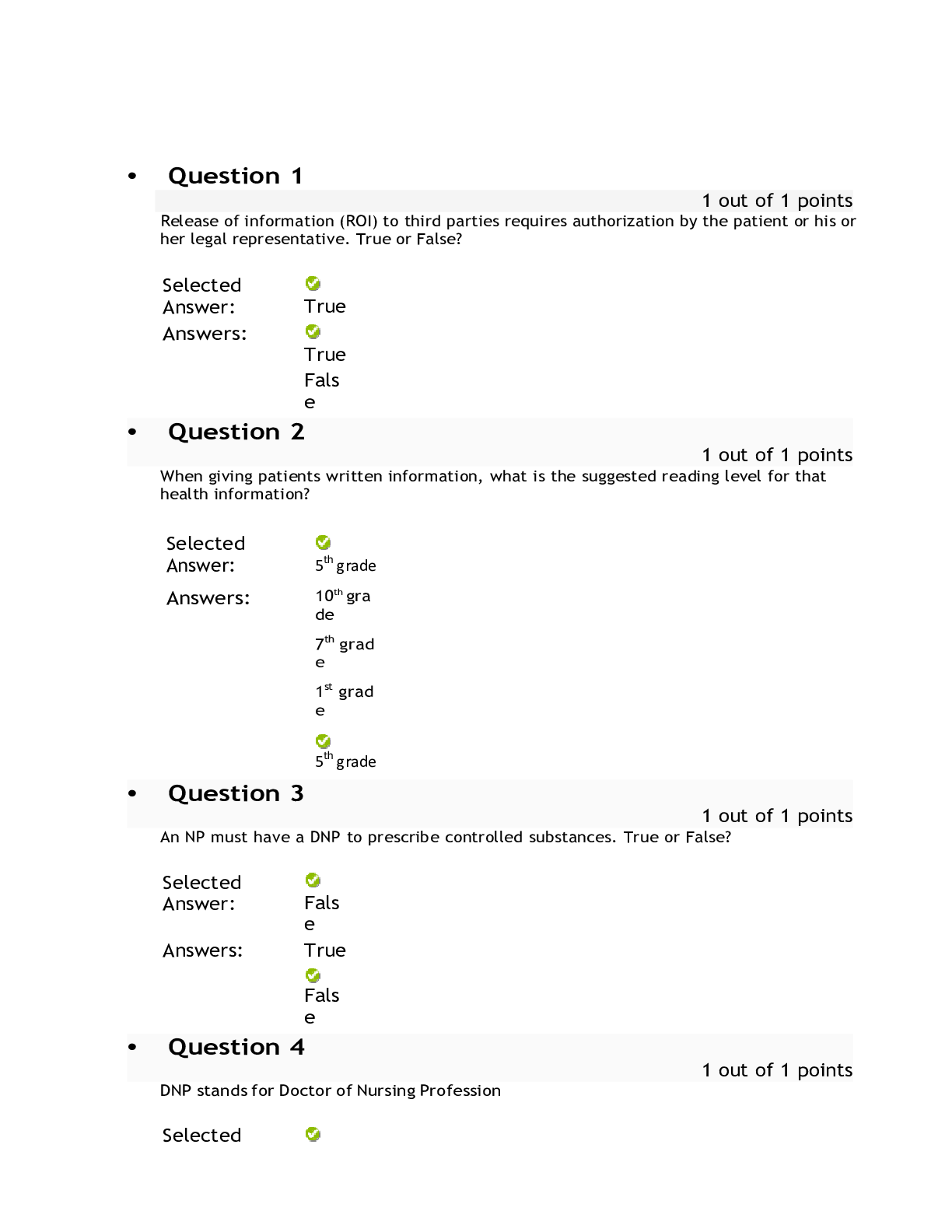
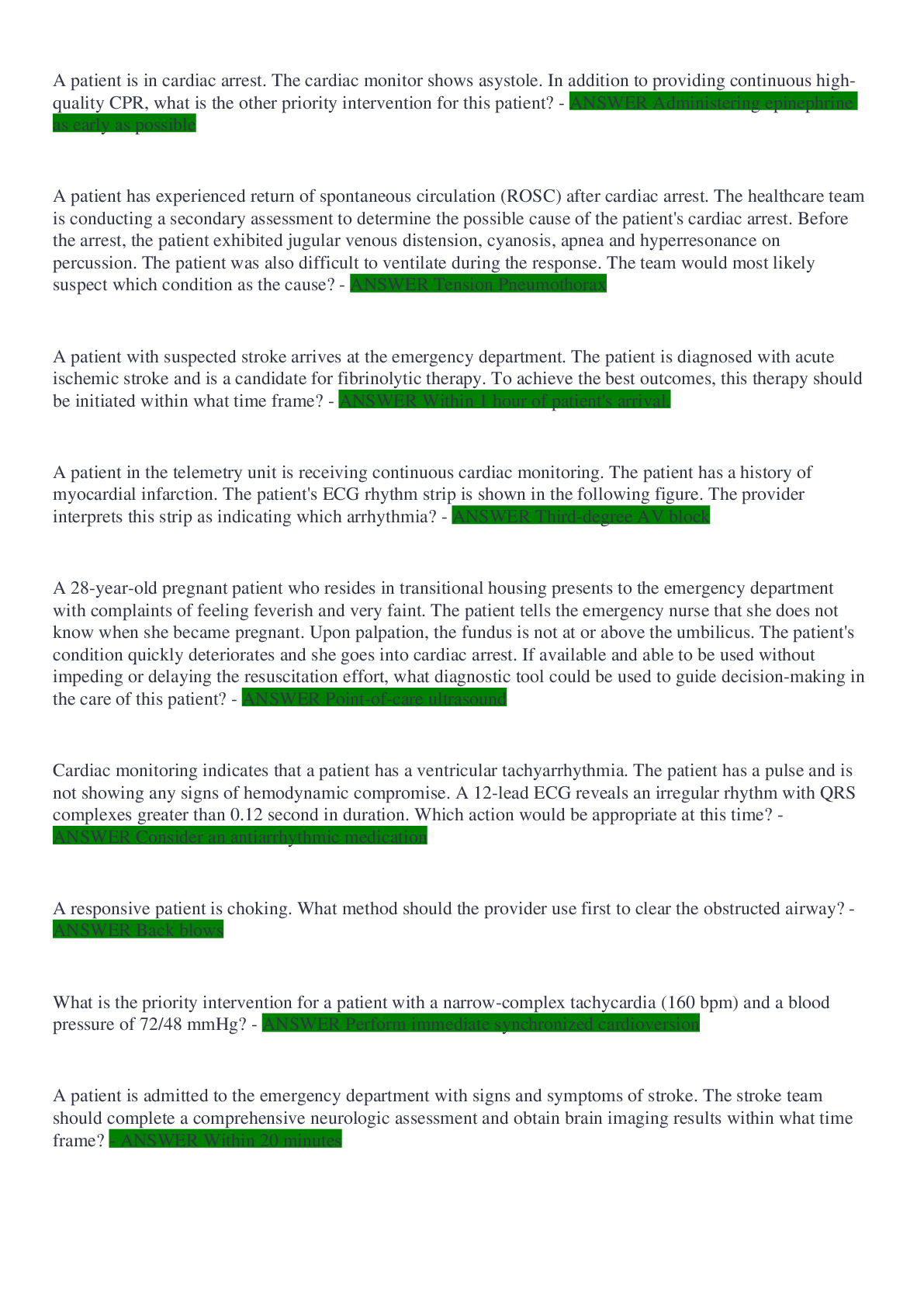
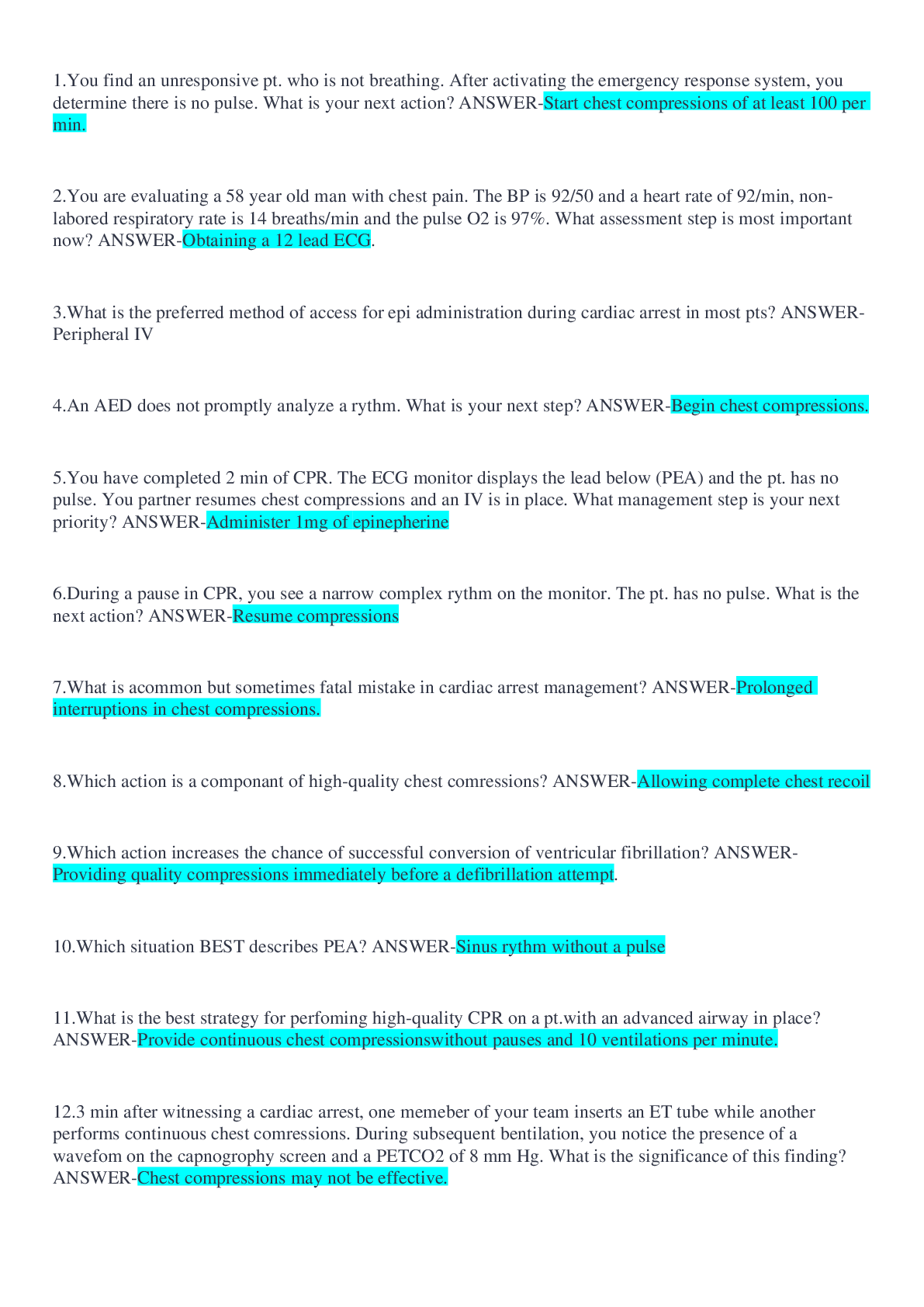



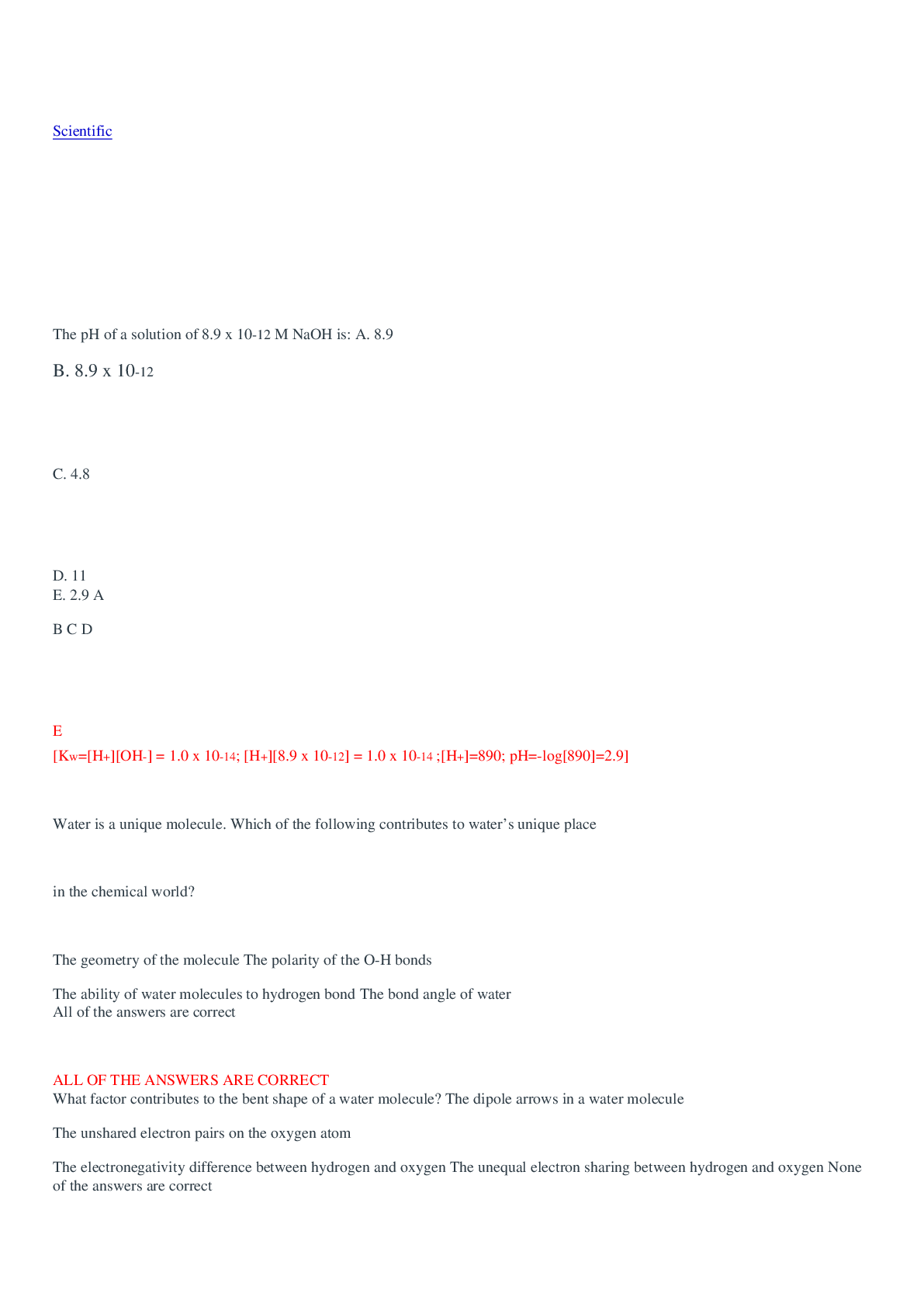


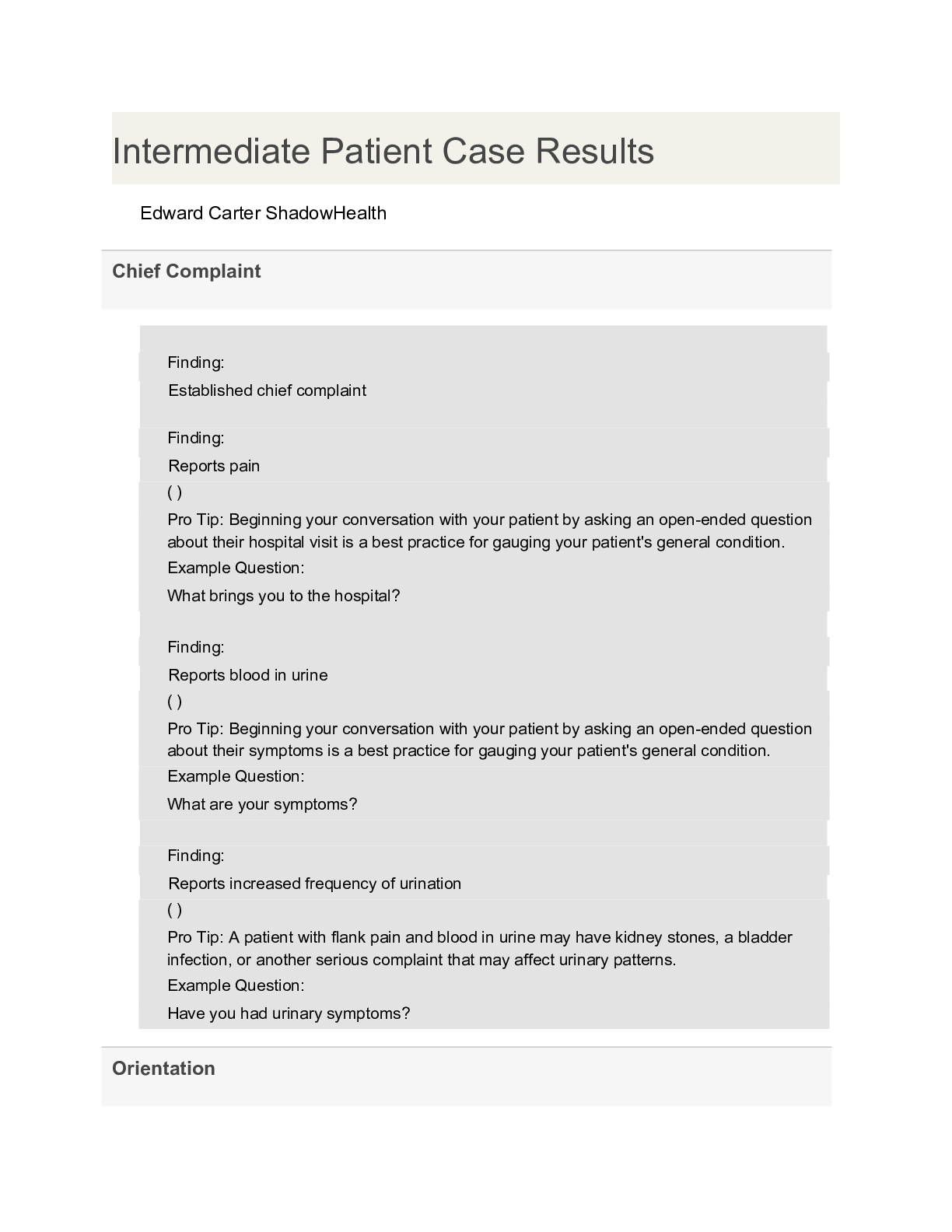
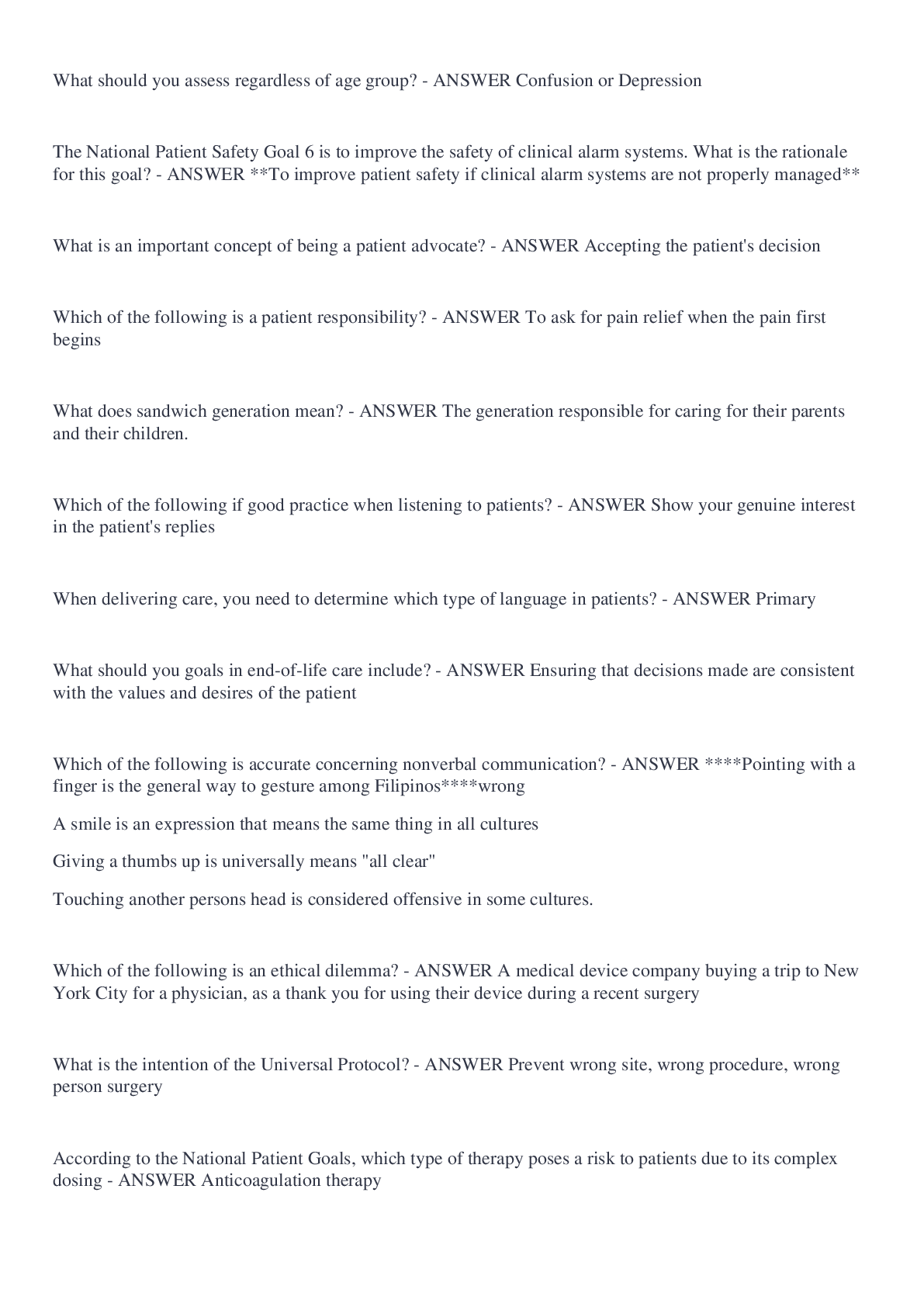



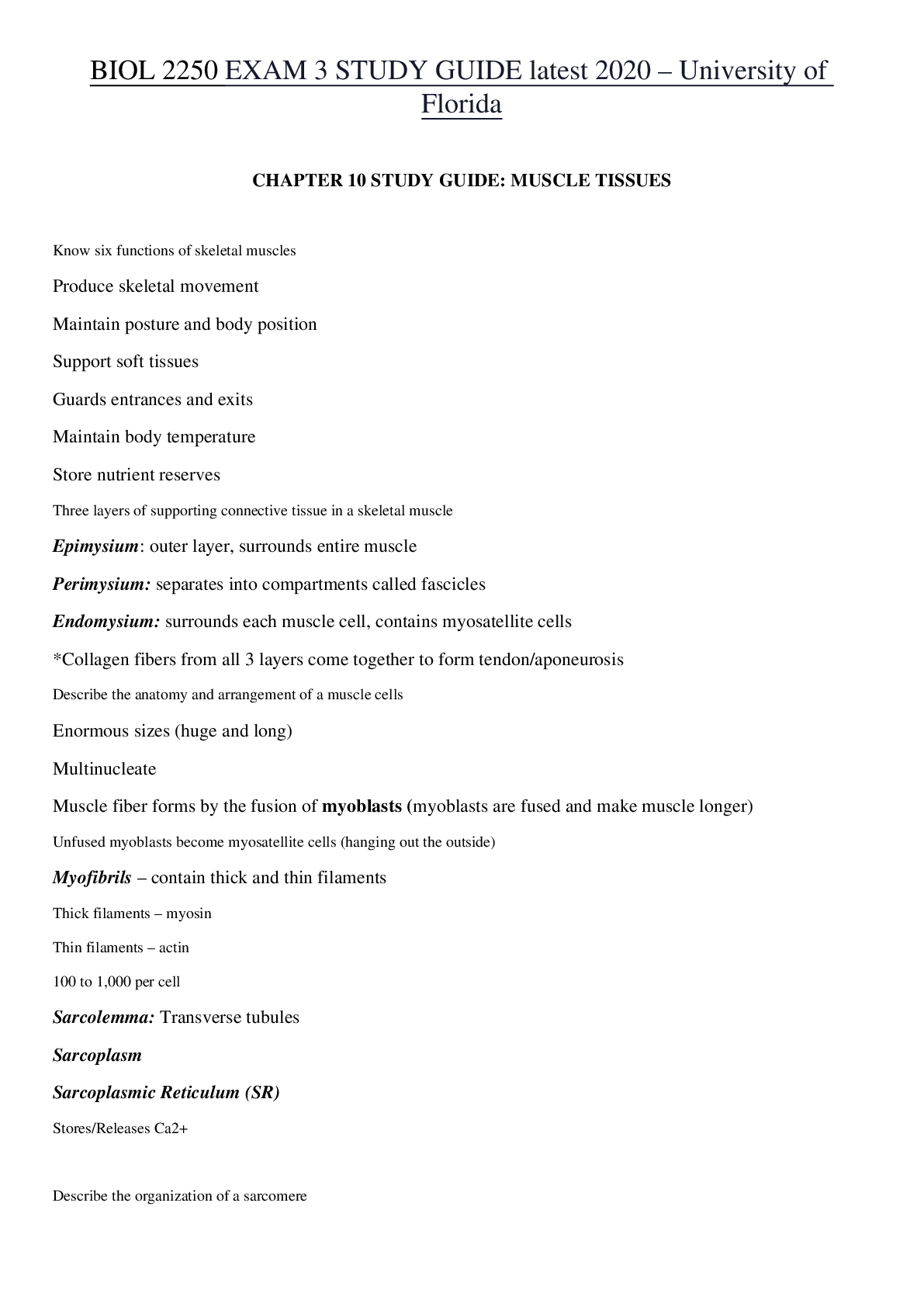

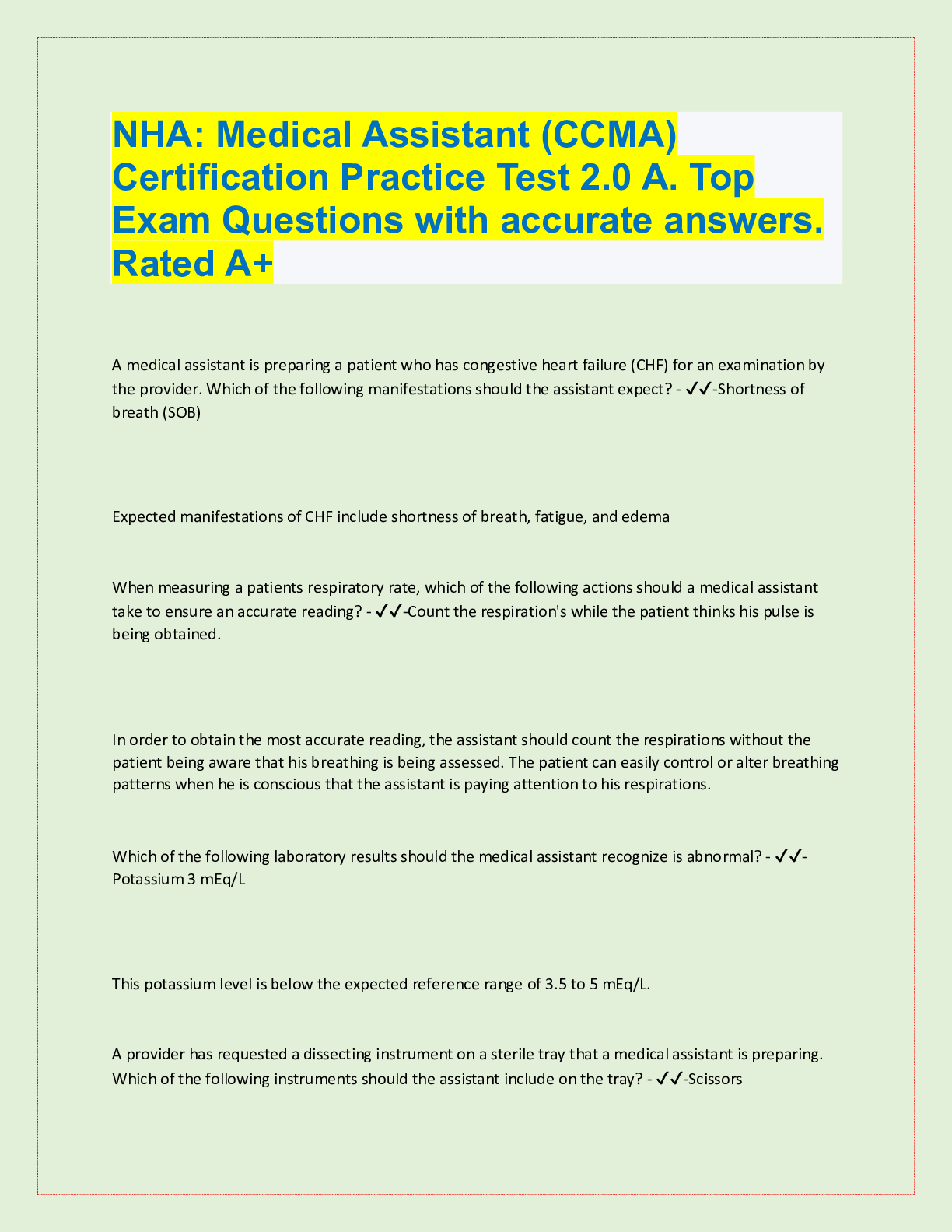
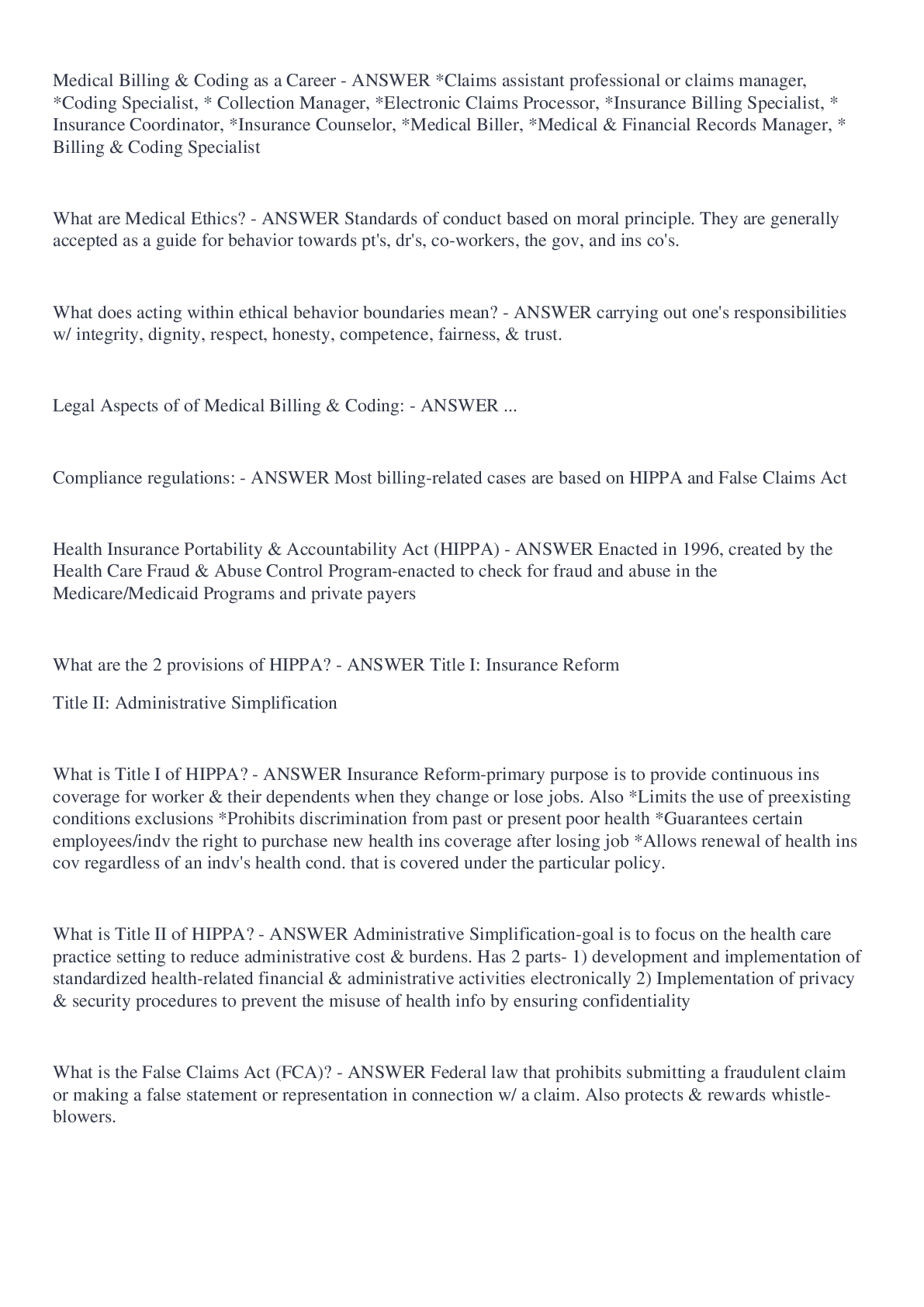
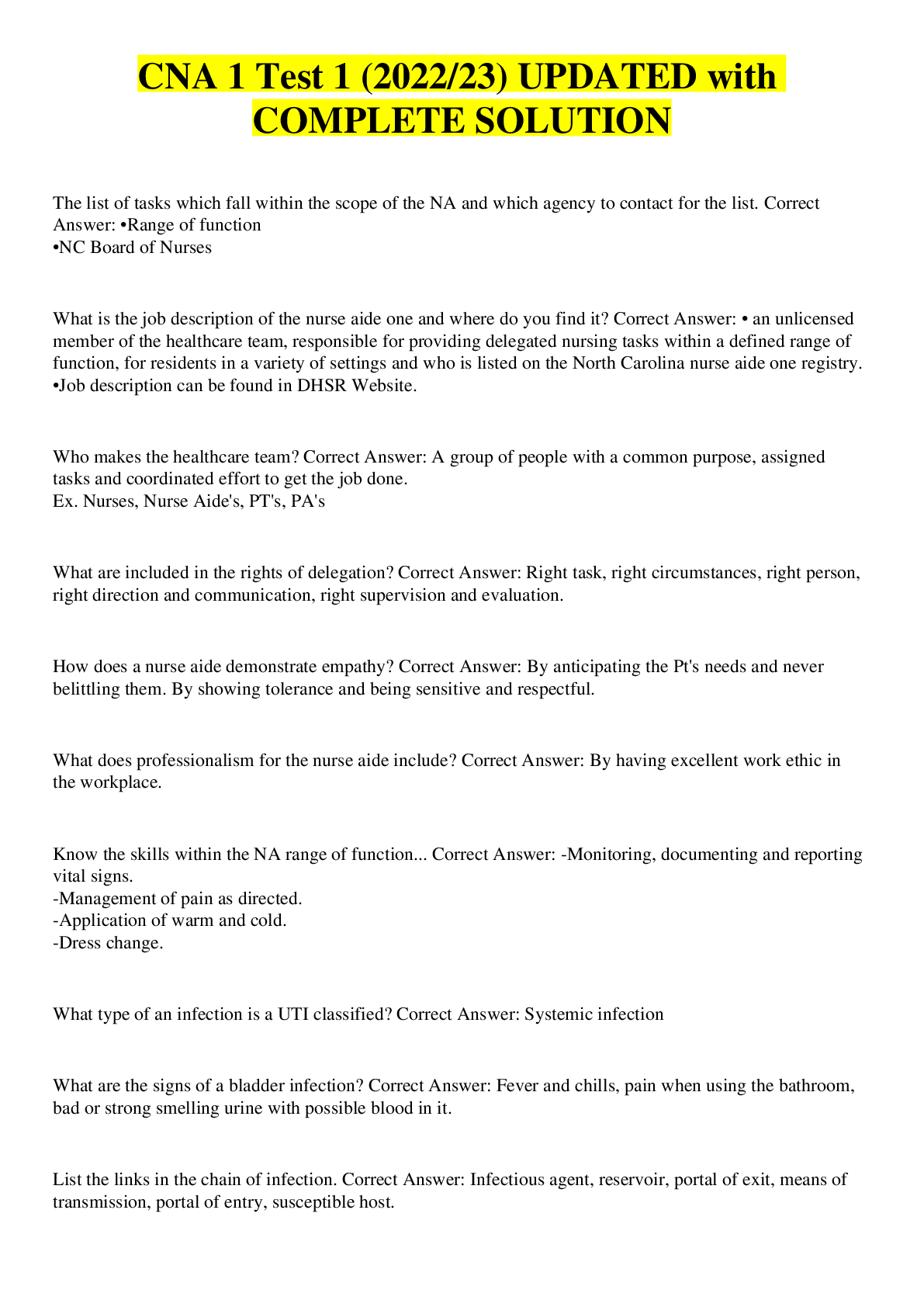
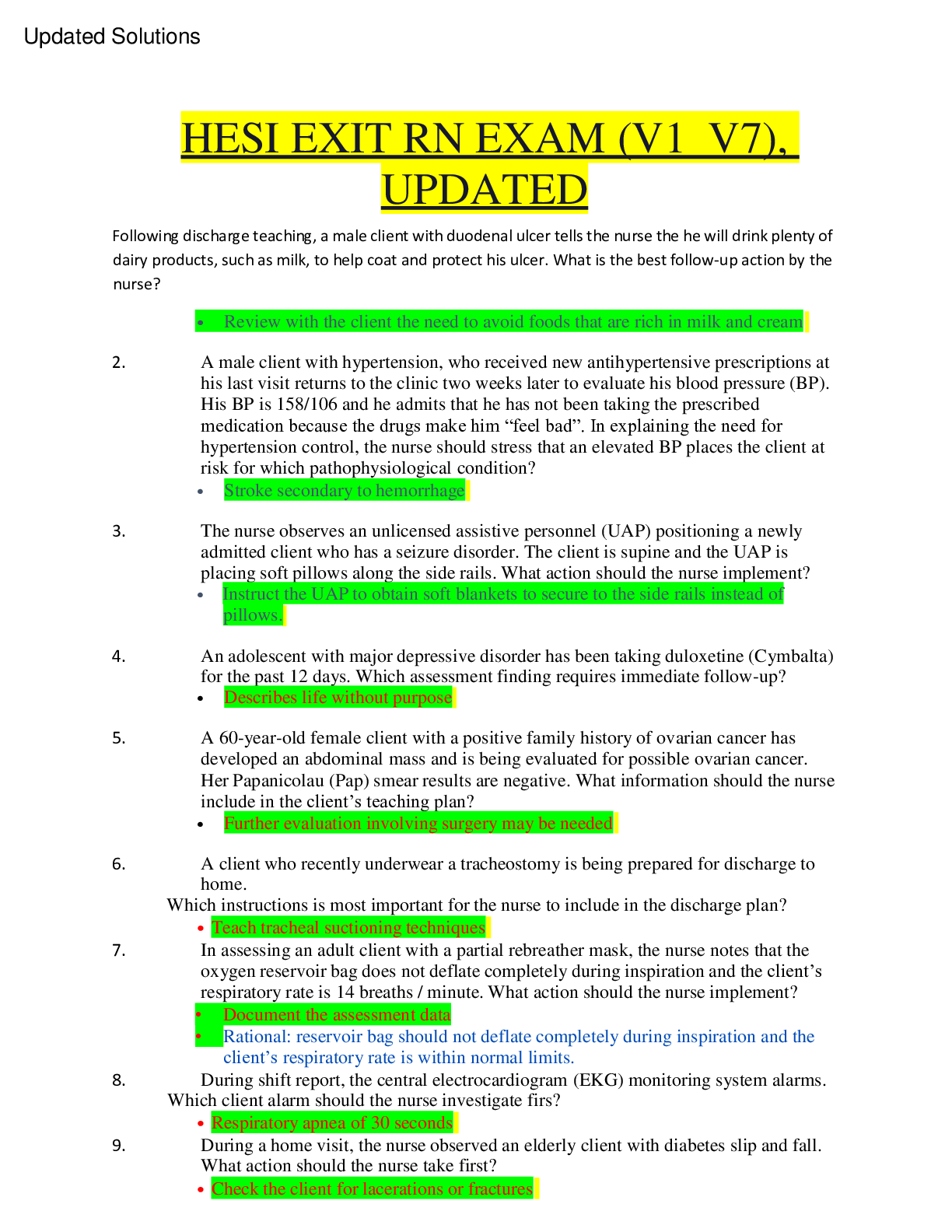

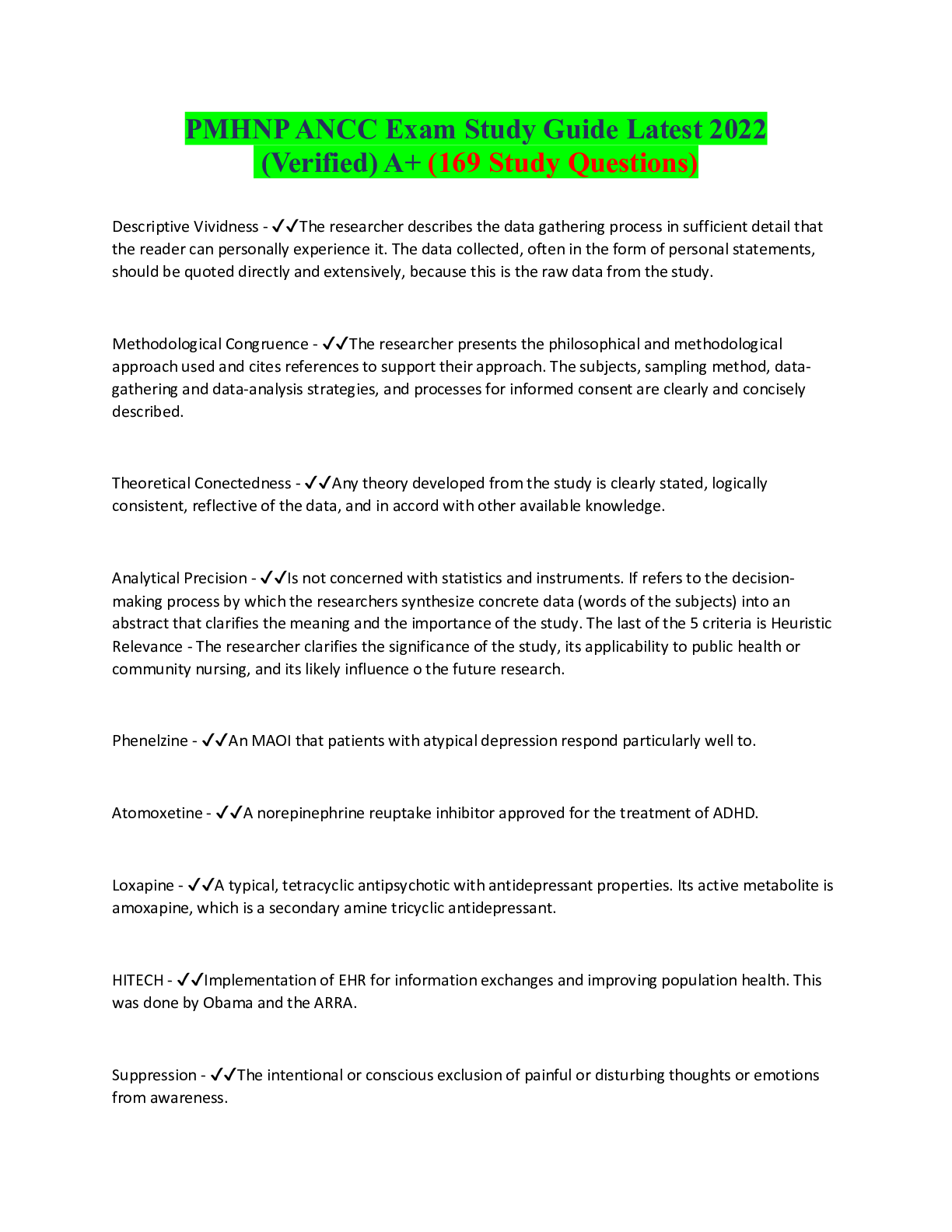
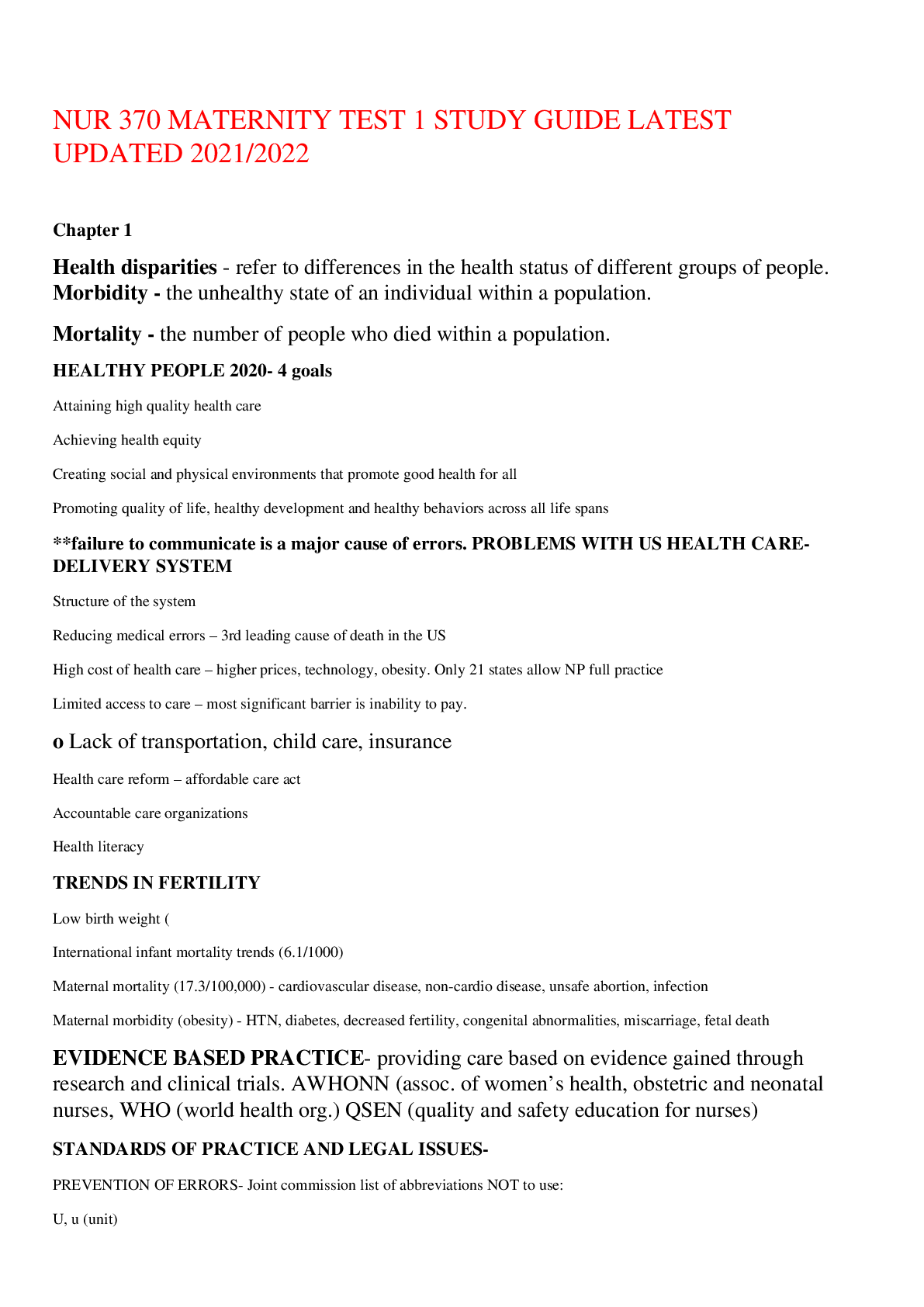

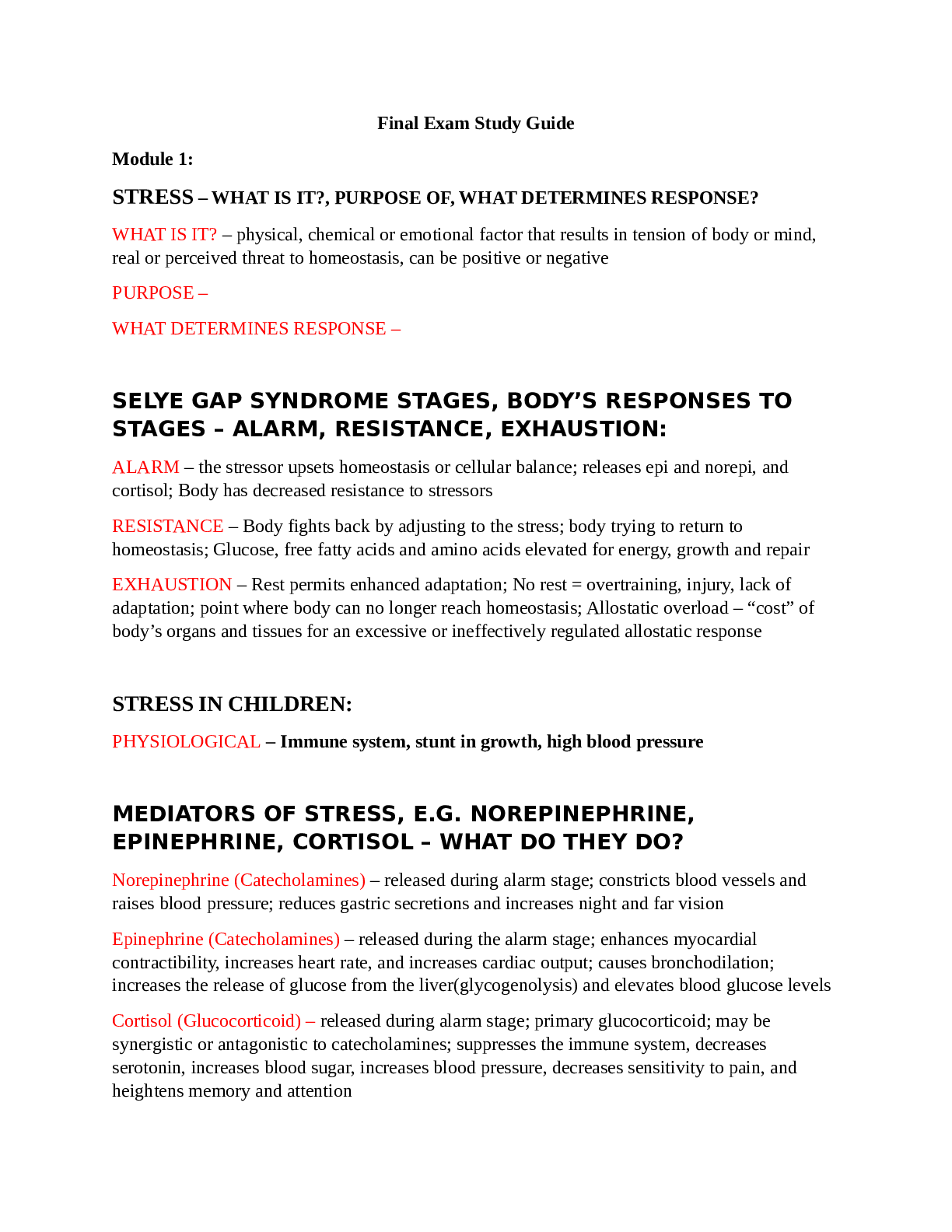
.png)
